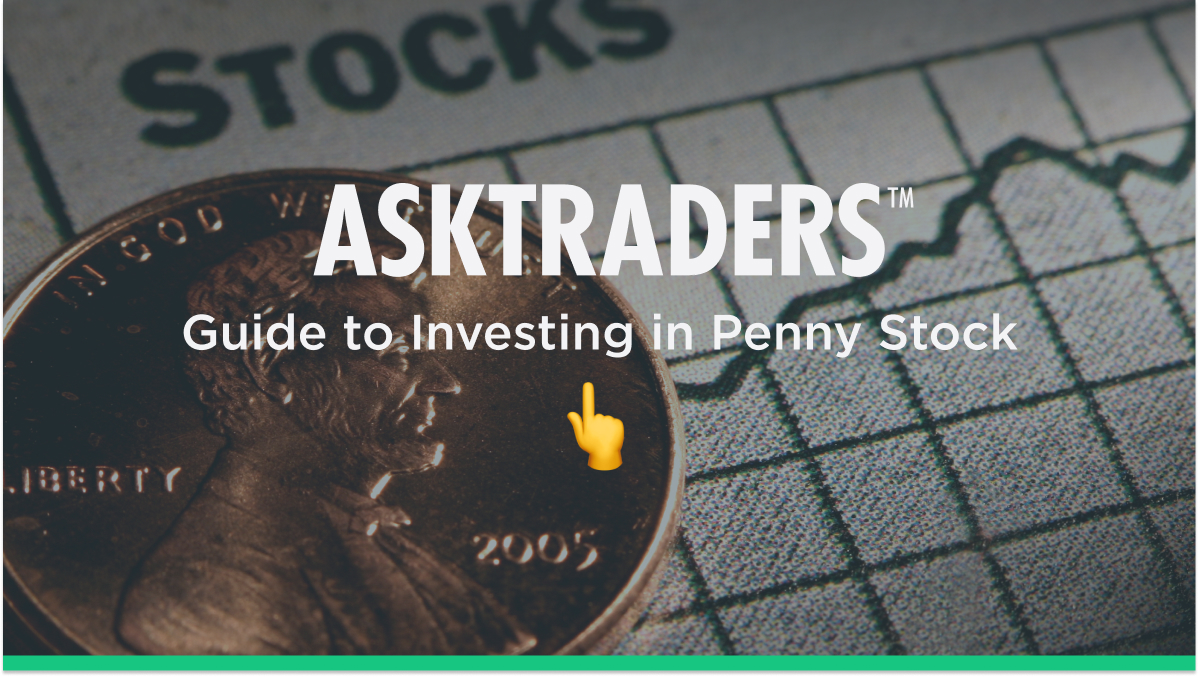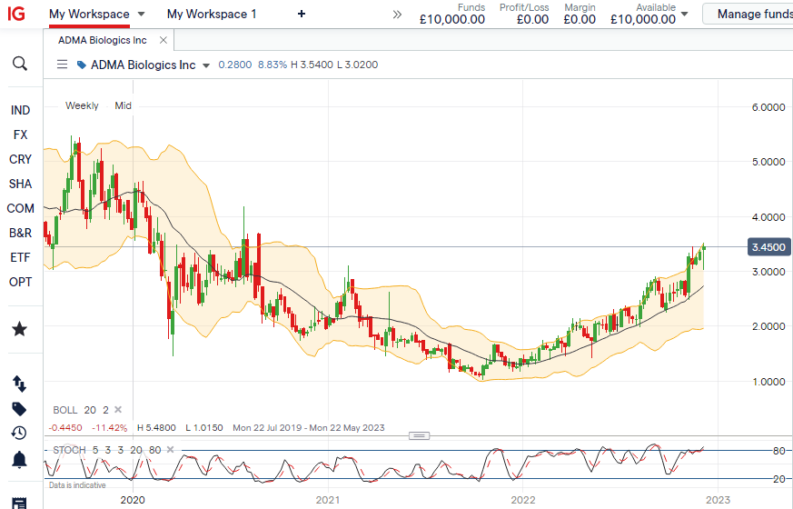When many of us think of penny stocks, we immediately conjure up images of Martin Scorsese’s black comedy The Wolf of Wall Street: charismatic stockbrokers living the high life and making money hand over fist. They make it seem all too easy – fun, even.
YOUR CAPITAL IS AT RISK

In reality, penny stock trading is rife with scams and insider trading. Only the bravest and most seasoned of traders dare to venture into this cutthroat world. It seems impossible to make money or any real profit. But is it? In this guide to penny stocks, you’ll learn:
Table of contents
What Are Penny Stocks?
Penny stocks are shares of a company that trades for $5 or less. The term had referred to shares that were trading for less than $1, but then the US Securities and Exchange Commission (SEC) expanded the definition and raised the threshold to $5.
Penny stocks are generally regarded as risky investments compared to established companies, given their high risk of going bankrupt. While there exists the possibility of large price appreciations and riches to be made, caution is still the watchword in this group. Volatility can provide opportunities for traders, but low liquidity can wreak havoc with any strategy.
Even though some of the companies with penny stocks are trading on large platforms such as the New York Stock Exchange (NYSE), most of the trades are transacted electronically over the counter (OTC) through the OTC Bulletin Board (OTCBB) or the privately owned OTC Markets Group. Listing requirements are a bit more lenient with these latter two platforms. There are still financial reporting standards to keep the public informed, but regardless of what may be in these reports, these stocks remain highly speculative in nature.
Penny stocks may not always remain in that category. When firms become successful and their stock values stay above the $5 level for a period of time, management may elect to issue more shares and comply with SEC listing requirements. More formal reporting on a periodic basis will be the result. The number and quality of investors in the firm may also trigger the filing of reports with the SEC, especially if the total number of investors exceeds 2,000.
Example of a Penny Stock
There are various examples of successful and unsuccessful dividend stocks. AMD, Micron Technology, Monster, Ford, and Qualcomm are all examples of penny stocks that have grown significantly and made substantial gains for shareholders.
However, there are an enormous amount of penny stocks that fail to get anywhere, with most putting the amount of penny stocks failing at about 90%. As a result, it is crucial that investors understand and adequately calculate the risks before investing in penny stocks.
Nevertheless, if you are still interested in investing in penny stocks, check out this list of top penny stocks.
Where Can You Buy and Sell Penny Stocks?
You can buy and sell penny shares via a broker that has listed the stock as a tradable instrument. Some brokers offer the stock directly, while others will allow you to trade in the stock with a contract for difference (CFD).
Buying and selling a penny stock as a CFD does not make you an owner of the share, as the CFD only tracks its underlying value. With a CFD, you are speculating on the direction that prices for your chosen asset might take in the future. Your deal is between you and your broker, and the terms of the agreement specify how the transaction will be conducted.
To own the stock, you have to open an account with a broker that lists its actual shares and not its CFD. Issues related to Bid/Ask spreads, liquidity, and delays in receiving funds after a sale come into play when you choose to buy and sell penny stocks directly from the market.
How Do You Buy and Sell Penny Stocks?
- Firstly, you have to open an online trading or investment account with a reputable broker.
- Next, log into your trading or investment account and search for the penny stock that you want to buy or sell.
- Choose an order type, either a market or limit order, and open an order ticket.
- Specify the number of shares you want to buy and your preferred price, and then execute the trade.
- You should receive a notification with the details of your order, including how it was filled.
How to Find the Best Penny Shares to Trade
Finding the best penny stocks to watch and trade is a process that can be accomplished by following the simple steps outlined below.

YOUR CAPITAL IS AT RISK
1. Do Some Basic Research
Penny stocks are risky investments, and doing some basic research such as a Google search will help you eliminate stocks with no viable business. You’ll be surprised to know that many penny stocks have no legitimate business and have massive debts.
You should avoid such stocks at all costs.
2. Focus On Trading Volatile Stocks
While volatility might be a bad trait in blue-chip stocks that rise slowly over several months and pay a dividend, it is a major asset when trading penny stocks.
Volatile stocks can have major moves intraday, such as a 50% gain, and it is these stocks that you should trade as a day trader.
Hence, you should stay away from non-volatile penny stocks that move slowly.
3. Look For High-Volume Stocks
You should only trade penny stocks with significant daily trading volume to avoid being stuck in a trade. We recommend stocks that have at least 200,000 daily traded volume.
However, conservative traders could limit themselves to stocks with a daily traded volume above 500,000 shares.
4. Look For Fundamental Drivers
It is best to trade stocks that have a fundamental driver or catalyst, such as a press release announcing drug trial results, positive financial results, or a new acquisition, among others.
Investors may react to positive news catalysts by bidding up the company’s stock price, while negative news could trigger a sell-off, both of which present excellent trade opportunities.
5. Use a Stock Screener
Using a stock screener is one of the easiest ways to find the best penny stock you can trade.
You can use the screener to find stocks that meet all the above criteria, including having a daily volume of over 200,000, trading at a specific price (say, above $1), and identifying the most volatile stocks.
6. Find a Trusted Advisor
There are many firms on the internet that have a good reputation for recommending penny stocks that are worth your consideration. These can be a source for further investigation with one caveat. When recommendations appear in the public marketplace or on a social media platform, the quality of the source is very important, but investor sentiment could have already driven stock prices to highs that should be avoided, even when legitimate.
These six tips should help you find the best penny stocks to trade on any given day while avoiding those stocks that have a high chance of resulting in you losing money.

YOUR CAPITAL IS AT RISK
Risks of Trading Penny Stocks
As we’ve alluded to, there are some major risks attached to penny shares trading that you need to be aware of. Here are some of them.
1. The Pump and Dump Scheme
The pump and dump scheme is a classic scheme employed by most if not all, penny stocks. The schemers, typically the company’s management, usually create interest in the company via different avenues, such as a press release.
They usually tout a new invention or a successful clinical trial for biotechnology stocks, which triggers a buying frenzy, causing the company’s stock to rally.
The company insiders then sell shares, causing the price to tank as they pocket huge profits.
2. Short-Selling Scams
These are the polar opposite of pump and dumps as the scammers collude with short sellers who borrow the company’s shares and then quickly sell them in the market.
The company’s share price will likely fall, given the huge volume of shares on offer. The short seller will then buy the shares at a lower price and return them to the owners.
3. Fraudulent Reverse Mergers
Reverse merger is a tool used by many small companies to list on the stock exchange without paying the hefty fees associated with an IPO.
However, fraudulent companies use the same strategy to get a listing on the stock exchange to fleece investors of their money before quickly going under. Doing some research should protect you from such scams.
4. Guru and Mining Scams
Guru scams are perpetrated through mass advertisements by people who claim to have uncovered the next big thing that will make investors money. These are usually elaborate scams that seem to have a lot of proof in the form of riches accumulated by the guru.
Mining scams work in much the same way as guru scams in that the perpetrators usually claim to have discovered some huge deposits of a precious metal such as gold. Investors who buy stocks in these scams typically end up losing their money.
Do not invest in such companies.
5. Offshore Scams
Offshore scams usually involve fraudsters listing a foreign company’s shares in the US, claiming that they can access foreign countries’ opportunities.
They usually end up selling shares of cheap foreign companies to unsuspecting US investors and then pocketing the difference, leaving investors holding low-priced, illiquid shares.
Now, Let’s Discuss the Benefits
However, despite the negatives, there are some benefits associated with trading penny stocks.
1. Cheap to Buy
The main advantage of trading penny stocks is that they are cheap to buy. Hence, you can get started with a small investing account.
2. High Probability for Huge Profits
The probability of the stock making huge percentage gains is relatively high, given their low stock prices and valuations.
3. Grow Trading Accounts Quickly
Penny stock investors also have a high chance of quickly growing their accounts if they take the necessary precautions.
So, let’s sum up penny stock trading.
Risks and Benefits of Penny Stock Trading
| Risks | Benefits |
|---|---|
| The pump and dump scheme | Cheap to buy, therefore more comfortable to start with small trading account |
| Short-selling scams | High probability of making substantial percentage gains |
| Fraudulent reverse mergers | High chance of growing trading accounts quickly |
| Guru and mining scams | |
| Offshore scams |
Penny Share Chart Patterns of Note
When you are searching for penny stock candidates, certain charting characteristics are key to selecting viable investments. Fundamentals such as recent news and how the industry is performing are also important, but a chart can quickly convey if you are wasting your time.
Most penny stocks will resemble our first example, T2 Biosystems, due to the impact of the COVID-19 pandemic and the general economic malaise. Many stocks have most likely fallen from grace with investors and had to become official penny stocks once their prices remained below $5 for a period of time. In any event, the factor that you will be looking for is renewed investor interest. This interest may appear as a sudden spike or series of spikes, as well as a series of small humps, as a reversal trend takes shape.
The interest may be due to positive news or the fact that a respected analyst has made a recent favourable recommendation. The reasons are important, but renewed interest could mean that the opportunity for profit is just around the corner. Be aware that other investors and traders will be reacting to the same visual stimulus.
Here is one example – ADMA Biologics:

Share prices appear to have formed a firm bottom and reversed. At $3.45, ADMA has reached a resistance level, which was support two years back. If it breaks through, then it could rise again and reward your effort.
Avoiding Penny Stock Fraud
The key to avoiding penny share fraud is doing some research on any company you want to trade or invest in before putting your money at risk. Remember, nobody cares about your hard-earned money more than you, which is why you’ll hear the common phrase, ‘do your due diligence’.
Researching a company will help you determine whether it is fraudulent or not, especially if it is a penny stock, as the number of scams in the penny stock market is staggering.
Your research assignment also includes your broker. Access to penny stocks is one thing, but having a trusted broker that complies with local regulations is quite another. Due to the high level of fraud in this arena, the US Congress adopted regulations decades ago that prohibit brokers from quoting OTC stocks for a company that has been lax in publishing timely financial statements. A lack of pertinent information is critical in this speculative arena, and fraud artists will use smoke and mirrors to confuse their targets. Demand current financial information.
How do you avoid the scammer’s siren call? The scammer will use trust and greed to sink their hook early on in the process. Here are a few warning signs:
- Beware any promises that seem too good to be true. Whether it is getting rich quick or you need to act quickly before the stock’s price is too high, you will be pressured to act due to ‘FOMO’ (Fear of Missing Out).
- Beware any deals where there is a claim of very low risk or high returns are guaranteed. Once again, the scammer is attempting to use greed and trust to win you over. They will likely produce pictures of wealthy clients enjoying a great lifestyle, but these are marketing tricks.
- How did the scammer get in touch with you? Solicitations can come out of the blue, especially if you have fallen for a scam at a previous time. Crooks sell these contact lists in the same way that marketing companies do. You may get a text message, an email, a cold call, or even something in the mail.
- Scammers tend to talk fast. Slow them down and ask for financial information in writing so that you can review it with your advisor. After your request, you will usually hear a loud click from the other end of the phone call.
- Be wary of any salesman who claims to be referred by a friend, your pastor, or someone else you trust. Gaining your trust is priority number one, and the preferred methods involve using a trusted person’s name or even showing up at your home in an expensive car, dressed like a successful and wealthy professional.
Ultimately, trust your gut and your personal research. If the deal seems legitimate after reviewing it and the paperwork with your investment advisor, be cautious in the amount you invest. Recklessness has no place on the front end. Do not bet the ranch, so to speak.

YOUR CAPITAL IS AT RISK
Five Penny Stock Trading Tips
The following tips should guide you when trading penny stocks and significantly increase your chances of success.
1. Avoid Penny Stocks That Trade on Pink Sheets
As an investor or trader, you need all the information you can get to make prudent decisions, and pink sheets do not provide the necessary information on a company’s finances.
2. Avoid Free Penny Stock Recommendations From Promoters and Experts
Remember the pump and dump schemes we discussed above? Fraudsters usually promote individual penny stocks to suck in unsuspecting investors before dumping their shares.
To avoid this, stay away from those unsolicited penny stock recommendations.
3. Always Use Limit Orders
Use limit orders when trading penny stocks instead of market orders, which can be easily manipulated by brokers and dealers, resulting in a bad entry.
By using limit orders, you guarantee that your order will be filled at your preferred price or at a better price, not at a worse price.
4. Make Use of a Stop-Loss Order
Ensure that you put a stop-loss order on all your trades to limit your losses if the trade goes against you. A stop-loss order will help protect your trading funds by getting you out of losing trades quickly while keeping you in winning trades for the duration of the move.
5. Use the Right Strategy
Trading penny shares based on support and resistance is one of the simplest and most effective strategies for penny stocks.
We highly recommend this strategy to beginner traders, given its simplicity. However, even experienced traders benefit from using the strategy.
Wrapping It Up
By now, you should have a solid idea of what penny stocks are and what it’s like to trade them. Before you take a ‘leap of faith,’ test the water and see if trading penny stocks is your thing. Choose a trustworthy broker that has a good reputation in the brokerage industry before investing too much of your capital in one place.
Penny stocks are high-risk and should only make up a small but acceptable portion of your entire portfolio. The invested funds should also be at a level that you can afford to lose.
Be on the lookout for unsolicited scammers. Unfortunately, the criminal element in our society is well organised and will approach you with an overly convincing proposal where time is of the essence. Take your time to evaluate the proposal. You are your first line of defence when it comes to avoiding fraud.
It would also be much better if you could consult someone who has experience in trading this type of stock. Make sure that you practise strict risk management. Good luck, and always trade safe!









